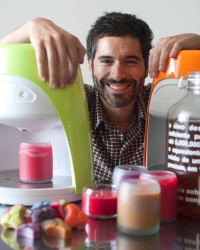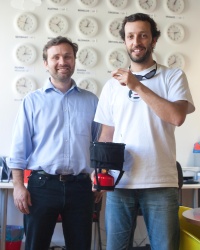Portuguese create two inventions per day, but not always do they hit the store shelves. The lack of entrepreneurship continues to be the stick in the wheels of progress.
The video that that went viral about what the Finns need to know about Portugal is full of references to inventions attributed to the Portuguese. From the Latin sail to the green lane toll payment system for highways, from prepaid mobile phone cards to the Pastel de Nata custard tart, furthermore including the development of new medicine or the invention of equipment for renewable energy, there is a lot of resourcefulness that makes Portugal one of the countries with a significant number of patent registrations per capita.
Curiously, the better part comes from independent inventors (38%) taking the lead over Universities (30%), Companies (26%) and Public Institutes (6%), according to the National Institute of Industrial Patents – INPI, which implies that we are a country of inventors and resourceful people, capable of creating objects or peculiar inventions like an anti-snoring pillow or a sterilization equipment for hospitals coveted by Israelis.
Even from garbage, we are able to dig good ideas, like Mr. Mario Silva did. From an early age he was always inventing things, the type that would take apart an object and assemble it into something different, he was always trying to see beyond what the object was designed to do. The question that he posed to himself was “How can people get fascinated with garbage?” The answer was quite simple: “to bring value to people. In this way, they will want to keep the garbage.” How can you do that? “By producing results with the garbage that people get excited with. Solutions of appealing homemade recycling.”

Candlemaker machine by Oon. Photo credits: Jorge Simão
From that aha moment, Mr. Silva came up with the idea of recycling used cooking oil and transforming it into candles. He contacted friends, created a work group and this was the beginning of Candlemaker, a machine that transforms used cooking oil into aromatic candles. Besides building the machine, Mr. Silva (who has a degree in Management and Marketing) created a company, Oon, to market his invention. Since the patent registry in 2007 until putting it into the market in 2010, he underwent a process that started with 100 euros for the patent application and ended up with a cost of 70 000 euros in three years. “There is a complexity of things to apply for: processes, drawings, names and more. It is really demanding,” he states.
Oon was only possible through venture capital funding. “It was not easy to turn the project into reality, because we are a country accustomed to have everything already made and who doesn’t want to put products in other markets because this requires capital and we don’t have the capacity to visualize things before others do”, he laments. This regretful tone of voice is understandable because Oon is in the risk of insolvency since the backers of the project don’t have the means, due to the crisis, to give it continuity, which would enter into an International activity, requiring a capital of 5 milllion euros, according to Mr. Silva.
Being an inventor is not enough. You must also be an entrepreneur. Most of the time, investment is the vulnerable heel of Achilles of the inventor that doesn’t have financial backup. Moreover, some inventions cannot be developed because the technical solution may already be in use in the market under another form. “The recognition that the idea is good is not easy, but José Mauricio, responsible for the INPI – Portuguese Institute of Industrial Property, considers that “it’s up to the own inventor to define a strategy to put his object into the market.”
Many inventors complain of the lack of support from the state and from the companies. Mr. Mauricio downplays the situation by saying “don’t suppose that the state has the obligation to open the doors to the success of your creation. The state can give some support, but the inventor must he himself define the strategy of continuity of his invention, its commercial application, the necessary patent and trademark registry, develop partnerships and guarantee the necessary capital through venture capitalists, taking into account the risk-benefit analysis.”
This discourse is a reality but not well assimilated by people who already earned their stripes as inventors. “You can not expect one to have a diversity of knowledge and is multifaceted to do everything. Often times, the inventor is not the best manager” notices Pedro Carradinha, creator of Heat-it, a mountaineering gear which fits gas stoves that enables its use under practically any weather.

Heat-It by Ortik. Photo credits - Jorge Simão
The 35 year old engineer (which at the beginning didn’t envision any commercial use for his invention, but rather from a necessity of a mountaineering enthusiast of having an accessory that protected the gas stove’s flame in severe weather conditions) confides that the duration of process that he underwent, was very demanding and long, starting with the prototype in 1999 until setting up shop in 2009.
“The first application for a patent was in 2005. Back then, I already knew Nuno Monge, with whom I later formed the company Ortik. We took over one year to understand the patent registry process. We wrote various texts and submitted different technical drawings”, he explains. In 2006 they headed to a trade fair in Germany to verify if the product had interest in the mountaineering market. The product has such an acceptance that some Canadians wanted to place an order for 1000 units.”

Heat-It mountaineering gear. Photo Credits: Jorge Simão
As soon as they returned to Portugal they searched for an entrepreneur of the textile industry to manufacture the product but the doors closed in on them. “Some didn’t even care to reply” assures Mr. Carradinha. Pedro and Nuno decided to send the specifications to China, and three weeks later, they received their product ready at no cost, with a note asking if this was exactly what they wanted. “Although we only had one series made, the Chinese bought the fabric for two series, but we have just paid one yet. They took a chance with us. Here, entrepreneurs are little receptive to new projects. They don’t get informed and don’t take risks”, they conclude.
Regarding investments, the owners of Ortik said that they first tried “the utopia of a bank finance”. Then they contacted friends and found an investing partner, but it was through the introduction of three business angels that the business took off. Later, a Risk Capital institution referred by the Ministry of Economy decided also to invest in the company, which by then already has a selection of products besides Heat-It, like tents and mattresses.
Actually, there are few financial supports, especially in times of crisis. Nevertheless the responsible for patent registries admits that giving support to inventors in the phase of searching investors “could be incentivized by the INPI Institute due to their good network of contacts.” Simultaneously, he highlights the importance of Technological Institutes that can have a fundamental importance with this kind of support. “I believe they give this type of support if asked. They are not granted due to lack of knowledge of the inventor himself. There are forms of support out there, but the inventors must make some basic research in order to obtain them”, he admonishes.
This is exactly what did Manuel Londreira, Fortunato da Costa and Hélder Gonçalves. The trio was able to give continuity to their projects – and least some of them in Manuel Londreira’s case, but they criticize the lack of support for the protection of their inventions and in some cases, even having their ideas misappropriated by third parties. Both, Fortunato da Costa and Hélder Gonçalves found closed doors over here contrasting with the doors wide open beyond frontiers.

Sterilization technique for medical equipment. Photo credits Rui Duarte Silva
The innovative method of sterilizing medical equipment created by Hélder Gonçalves was not able to “overrun the lobbies established in the medical community in Portugal”, not even by putting some machines under consignment “at zero-cost so that they could give them a try”. Although the equipment has lower costs than that of its competition, the truth is that it continues to loose tenders in an outrageous manner”. Over here he was only able to sell two equipments, one to the Mirandela Hospital and another to the Maternity of Coimbra. The idea however was well accepted by an Israeli multinational, Tuttnauer, which bought the process. However, the inventor clarifies that the primary components of the equipment continue to be manufactured in Portugal.

Anti-carjacking device. Photo credits - Rui Duarte Silva
Another example of how technology can be put to good use is the Anti-Carjacking system created by Manuel Londreira. Born in São João da Madeira, Manuel Londreira invented the Intelligent Multi-use System by Mobile Phone in 2001 but it took seven years to commercialize this anti-carjacking system that mobilizes by mobile phone the stolen vehicle. The project was awarded a golden medal in the Exhibition of Inventions in Geneva (the world’s largest marketplace for inventions) and entered the market by forming a partnership with the GPS manufacturer Novotrónica. This year, Mr. Londreira has already developed another Project named Equidade Fiscal/Social (Tax and Social equitability), that curbs tax evasion.
According to José Maurício, “there are about 100 or 150 individual inventors, being most of them associated with Corporations or Universities. Working on their own, there must be around 20 inventors”. Every year, the INPI receives approximately 18 to 20 thousand trademark registrations, but in reality, the numbers have little significance. “In absolute terms, new patent applications are not that strong. Comparatively with other European countries, the ideal would be to receive between 2500 to 3000 applications per year” warns José Maurício. He adds that in 2011 they are expecting between 800 to 900 patent applications.
The question is if what matters to Portugal is the result of the activity of the individual inventors or the activity produced by inventors in Corporations and Universities? For the director of the Patent Registry, the results of the latter have greater weight, even though there are Portuguese who are awarded in the Exhibition of Inventions in Geneva every year. However “winning a prize and a medal are not enough. One of the patentability requirements is that the claimed invention is useful for some industrial application”. This is where everything gets complicated, especially for the independent inventors.
The Patent Registry director from the INPI draws attention to the fact that there are a lot of inventors who don’t respond to the notifications of the INPI regarding the process of registry, thus losing their rights, while still others let their patent validity lapse.
Article written by Alexandra Simões de Abreu which originally appeared in the Magazine Revista Única of the Portuguese Newspaper Expresso dated May 21, 2011 and translated under permission by BestInPortugal. Photo credits by Jorge Simão/Revista Única and Rui Duarte Silva/Revista Única.
Other related post: Innovation in Portugal

{ 1 trackback }